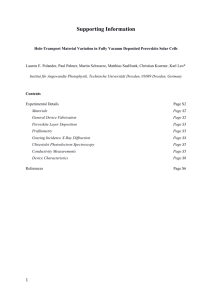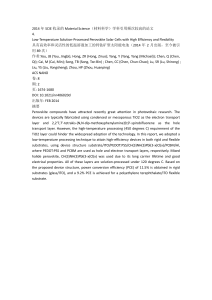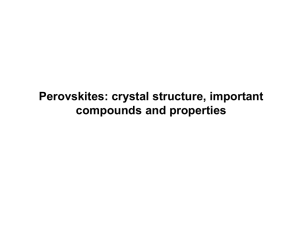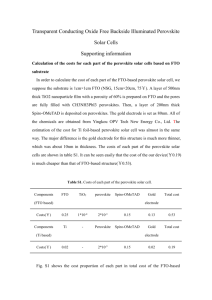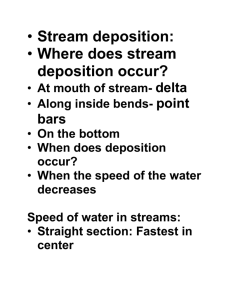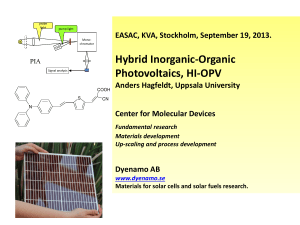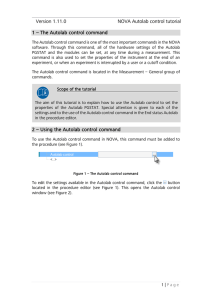New Iridium complex as additive to the spiro
advertisement
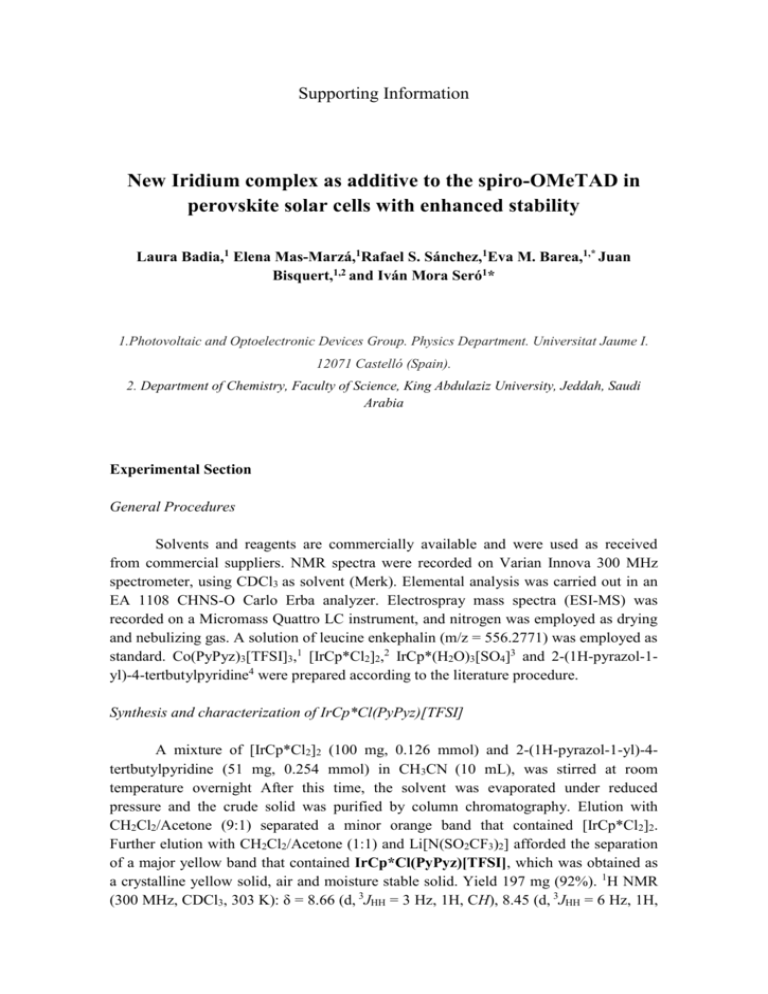
Supporting Information
New Iridium complex as additive to the spiro-OMeTAD in
perovskite solar cells with enhanced stability
Laura Badia,1 Elena Mas-Marzá,1Rafael S. Sánchez,1Eva M. Barea,1,* Juan
Bisquert,1,2 and Iván Mora Seró1*
1.Photovoltaic and Optoelectronic Devices Group. Physics Department. Universitat Jaume I.
12071 Castelló (Spain).
2. Department of Chemistry, Faculty of Science, King Abdulaziz University, Jeddah, Saudi
Arabia
Experimental Section
General Procedures
Solvents and reagents are commercially available and were used as received
from commercial suppliers. NMR spectra were recorded on Varian Innova 300 MHz
spectrometer, using CDCl3 as solvent (Merk). Elemental analysis was carried out in an
EA 1108 CHNS-O Carlo Erba analyzer. Electrospray mass spectra (ESI-MS) was
recorded on a Micromass Quattro LC instrument, and nitrogen was employed as drying
and nebulizing gas. A solution of leucine enkephalin (m/z = 556.2771) was employed as
standard. Co(PyPyz)3[TFSI]3,1 [IrCp*Cl2]2,2 IrCp*(H2O)3[SO4]3 and 2-(1H-pyrazol-1yl)-4-tertbutylpyridine4 were prepared according to the literature procedure.
Synthesis and characterization of IrCp*Cl(PyPyz)[TFSI]
A mixture of [IrCp*Cl2]2 (100 mg, 0.126 mmol) and 2-(1H-pyrazol-1-yl)-4tertbutylpyridine (51 mg, 0.254 mmol) in CH3CN (10 mL), was stirred at room
temperature overnight After this time, the solvent was evaporated under reduced
pressure and the crude solid was purified by column chromatography. Elution with
CH2Cl2/Acetone (9:1) separated a minor orange band that contained [IrCp*Cl2]2.
Further elution with CH2Cl2/Acetone (1:1) and Li[N(SO2CF3)2] afforded the separation
of a major yellow band that contained IrCp*Cl(PyPyz)[TFSI], which was obtained as
a crystalline yellow solid, air and moisture stable solid. Yield 197 mg (92%). 1H NMR
(300 MHz, CDCl3, 303 K): δ = 8.66 (d, 3JHH = 3 Hz, 1H, CH), 8.45 (d, 3JHH = 6 Hz, 1H,
CH), 7.97 (d, 3JHH = 3 Hz, 1H, CH), 7.91 (d, 3JHH = 3 Hz, 1H, CH), 7.56 (dd, 3JHH = 6
Hz, 3JHH = 3 Hz, 1H, CH), 6. 88 (m, 1H, CH), 1.75 (s, 15H, CH3), 1.41 (s, 9H, CH3).
13
C{H} NMR (300 MHz, CD3CN, 303 K): δ = 168.8 (C), 150.6 (C), 149.3, 143.7,
132.0, 123.7, 112.9, 110.3 (CH), 90.1 (C), 36.9 (C), 30.3 (CH3), 9.0 (CH3). 19F NMR
(282 MHz, CDCl3, 303 K): δ = 78.9. HRMS (+)-ESI-TOF-MS of [M]+, monoisotopic
peak 564.1754, calcd 564.1754, εr = 0.7 ppm. Anal. calcd. for C24H30N4IrClS2O4F6
(mol. wt. 844.31) C, 34.14; H, 3.58; N, 6.64. Found: C, 34.00; H, 3.62; N, 6.59.
Cyclic Voltametry Characterization.
The HOMO level for Ir-complex was obtained by Cyclic Voltametry (CV) using
an Autolab Potentiostat PGSTAT-30 from Metrohm Autolab. A three-electrode
configuration was used employing a platinum wire as the counter electrode, a platinum
disk (2 mm diameter) as working electrode and Ag/AgNO3 (0.01M) as reference
electrode. The supporting electrolyte was 0.1 M of tetrabutylammonium
hexafluorophosphate (TBAPF6) in acetonitrile (MeCN).
The CV curve obtained from de measurement was calibrated using the Fc+/Fc
redox couple as an external standard.(Figure S1)
15
Current (uA)
10
5
0
-5
-10
-0.4 -0.2
0.0
0.2
0.4
0.6
Potential (V vs. Ag/Ag+)
Figure S1. CV measurement of Fc+/Fc redox couple in MeCN containing 0.1 M
TBAPF6 at a scan rate of 100 mV/s
The half-wave potential of the Fc+/Fc redox couple was estimated from the
anodic and cathodic peak potentials (Epa and Epc respectively) using the equation:
𝐸1⁄2 = 1⁄2 (𝐸𝑝𝑎 + 𝐸𝑝𝑐 ). The half-wave potential obtained from Figure 1 was 0.07 V
vs. Ag/Ag+.
The CV measurement obtained for the Ir-complex calibrated using the Fc+/Fc
redox couple is shown in Figure S2.
25
Current (uA)
20
15
10
5
0
-5
0.0
0.5
1.0
1.5
2.0
+
V vs. Fc /Fc
Figure S2. CV measurement of 1 mM Ir-complex in MeCN containing 0.1 M TBAPF6
at a scan rate of 100 mV/s
The HOMO energy level was calculated using the equation5
𝐸𝐻𝑂𝑀𝑂 = −(𝐸 [𝑜𝑛𝑠𝑒𝑡,𝑜𝑥 𝑣𝑠.
𝐹𝑐 + +𝐹𝑐]
+ 5.1)𝑒𝑉
Where E[onset,ox vs. Fc+/Fc] is the onset oxidation potential relative to Fc+/Fc. The
value obtained from the measurement was EHOMO = -6.31 eV. The LUMO energy level
was estimated adding the optical band gap value to the HOMO energy level 𝐸𝐿𝑈𝑀𝑂 =
𝐸𝐻𝑂𝑀𝑂 + 𝐸𝑔,𝑜𝑝𝑡 . The optical band gap obtained from the absorption spectra (Figure S3)
was 3.83 eV and the LUMO energy level calculated was ELUMO= -2.51 eV.
Absorbance
0.20
0.15
0.10
0.05
0.00
250
300
350
400
450
500
Wavelenght (nm)
Figure S3. Absorption spectra of Ir-complex
Preparation of the devices
Substrate preparation
Fluorine doped tin oxide (FTO) coated glass sheets (2.5 x 2.5 mm, Pilkington
TEC15, ∼15/sq resistance) were etched with zinc powder and HCl (2M) to obtain
0.224 cm2 of active electrode area. The substrates were cleaned with soap (Hellmanex)
and rinsed with milliQ water and ethanol. Then, the sheets were sonicated for 15
minutes in a solution of acetone:isopropanol (1:1 v/v), rinsed with ethanol and dried
with compressed air. After that, a UV/ozone treatment was performed for 15 minutes.
Finally, a TiO2 blocking layer was deposited onto the substrates by spray pyrolysis at
450ºC, using a titanium diisopropoxide bis(acetylacetonate) (75% in 2-propanol, SigmaAldrich) solution diluted in ethanol (1:39, v/v), with oxygen as carrier gas. After the
spraying process the films were kept at 450 ºC for 5 minutes.
Perovskite deposition
The perovskite precursor solution (100 µl), prepared by reacting 2.64 M of
methylammonium iodide and 0.88 M of PbCl2 at a 3:1 mol ratio in DMF, was spincoated inside the glove box at 2000 r.p.m. for 60 s. After the deposition, the substrate
was kept at room temperature for 15 min. Next, the substrates were heated at 100 ºC
during 1 hour in an oven under air stream.
Hole transport layer (HTM) deposition
A 300-400 nm-thick of HTM was deposited on top of the perovskite substrates
by spin coating at 4000 r.p.m for 30 s under air conditions, using 100 μL spiroOMeTAD solutions. In this study three different solutions were employed. The standard
spiro-OMeTAD solution (for the reference perovskite device) was prepared by
dissolving 72.3 mg of (2,2′,7,7′-tetrakis(N,N′-di-p-methoxyphenylamine)-9,9′spirobifluorene), 28.8 μL of 4-tert-butylpyridine and 17.5 μL of a stock solution of 520
mg/mL of lithium bis(trifluoromethylsulphonyl)imide in acetonitrile, in 1 mL of
chlorobenzene. Reference devices were prepared with this recipe. In addition HTM with
metal-complex additives were also prepared. The HTM solutions containing 10 %
molar ratio of Co or Ir complexes were prepared adding 29.6 μL of a stock solution of
300 mg/mL (Co(PyPyz)3[TFSI]3) in acetonitrile1 or 33.2 μL of a stock solution of 150
mg/mL IrCp*Cl(PyPyz)[TFSI] in acetonitrile, to 1 mL of the standard HTM solution.
Gold electrodes deposition
The deposition of 60 nm of gold was performed by thermal evaporation under
ultrahigh vacuum conditions, using a commercial MBraun vacuum chamber.
Characterization of the devices
Current density-voltage (J-V) curves were performed under 1 sun illumination,
AM 1.5 G (100 mW·cm-2) using a solar simulator (ABET Technologies Sun 2000) with
a Keithley 2400, previously calibrated with an NREL-calibrated Si solar cell. All the
measurements were performed with a mask of 0.15 cm2 and without encapsulation. The
electrochemical Impedance spectroscopy measurements were carried out by means of a
FRA equipped PGSTAT-30 from Autolab under 1 sun illumination conditions at
different applied voltages and applying a 30 mV A/C voltage perturbation over the
constant applied bias with a frequency ranging between 1 MHz and 0.05 Hz.
References
1
2
3
4
5
Jun Hong Noh, Nam Joong Jeon, Yong Chan Choi, Md K. Nazeeruddin,
Michael Gratzel, and Sang Il Seok, Journal of Materials Chemistry A 1 (38),
11842 (2013).
R. G. Ball, W. A. G. Graham, D. M. Heinekey, J. K. Hoyano, A. D. McMaster,
B. M. Mattson, and S. T. Michel, Inorganic Chemistry 29 (10), 2023 (1990).
Seiji Ogo, Nobuyuki Makihara, and Yoshihito Watanabe, Organometallics 18
(26), 5470 (1999).
Nail M. Shavaleev, Rosario Scopelliti, Etienne Baranoff, Michael Grätzel, and
Mohammad K. Nazeeruddin, Inorganica Chimica Acta 383 (0), 316 (2012).
Claudia M. Cardona, Wei Li, Angel E. Kaifer, David Stockdale, and Guillermo
C. Bazan, Advanced Materials 23 (20), 2367 (2011).


